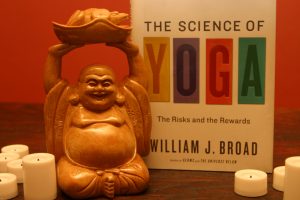for practitioners – it’s self-evident
Having just completed my first full year of regular yoga practice, I decided to celebrate by reading the book “The Science of Yoga” by William Broad.
Prior to reading the book, I can tell you that yoga has made a huge difference in my life. Although the evidence suggests decreased metabolism, I’ve lost weight since starting yoga and feel more healthy overall. This is probably secondary to the other influence yoga has on one’s life such as eating better, being more active in general, and improvement in overall attitude. My improvement in mood permeates all aspects of my life.
I practice Bikram, also known as ‘hot’ yoga, because it found me. After trying many styles, this is the one I enjoyed most. With over 20 million people in the United States practicing any number of yoga styles, it is apparent others have experienced similar benefits!

As for the book, it mostly confir med what I have experienced but now I learned the science behind the outcomes, without having to pull all the research myself. It starts out with a little information on the history and evolution of yoga. It then addresses the scientific evidence of benefits as well as false claims over the years. Finally, the book ends with evaluation of the more obscure aspects of yoga, such as creativity and the Kundalites.
med what I have experienced but now I learned the science behind the outcomes, without having to pull all the research myself. It starts out with a little information on the history and evolution of yoga. It then addresses the scientific evidence of benefits as well as false claims over the years. Finally, the book ends with evaluation of the more obscure aspects of yoga, such as creativity and the Kundalites.
Without giving the entire book away, there were a few interesting things, in regards to the research, that I found and will take forward to encourage myself to continue my yoga practice and share with my patients if they ask me about yoga benefits.
1. Yoga appears to slow the biological clock. This is suggested by the finding that when telomerase activity, the enzyme that adds DNA at the end of chromosomes, is measured it is increased in men who underwent yoga training.
2. Yoga improves mood. It’s been shown to increase GABA levels, a neurotransmitter linked to mood. In a small study in Boston, GABA was measured before and after an hour-long session of yoga and compared it to a control group who read magazines and popular fiction for an hour. It was found that GABA increased an average of 27% in yoga practitioners and interestingly, those who had practiced the longest demonstrated the greatest rise in GABA levels.
3. Yoga increases right brain activity. Iyengar yoga students who practiced for 3 months demonstrated increased activity on the right side of the brain, the side responsible for higher order conscious functioning.
4. Yoga improves many general health measures. In a 2010 review article, yoga was shown to improve balance, reduce fatigue, decrease anxiety, cut stress, improve sleep, reduce pain, lower cholesterol, and overall improve measures of quality of life (social lives, family relations, and sex lives).
However, the studies also suggest that yoga is not the perfect exercise as some of the claims, about physical fitness, and certain position’s safety have come into question.
1. Yoga decreases metabolic rate. It is not aerobic exercise and in fact in studies show that the VO2 (a measurement of oxygen consumption/aerobic activity) decrease. This suggests that weight loss is not a key function of yoga. However, in a study comparing Hatha yoga practitioners, stationary bike riders, and those who did no activity for 4 months found, while bike riders had an increase in aerobic capacity, yogis felt better about themselves and thought they looked better.
2. Yoga can be dangerous. Reports exists of nerve damage from extended periods in one position by cutting off blood flow and certain postures such as neck stands, head stands, and shoulder stands have been linked to strokes. The heat of the Bikram studio also poses some dangers of overstretching. I’ve experienced directly some of the benefits, but have also pulled a muscle while stretching beyond my limits in the heated room. Consciously practicing yoga, and being aware of the potential dangers, is one way to reduce these risks.
Overall, I found it to be an interesting and well organized read, going back through the history of yoga and discussing the scientific research on an array of topics organized by topic: health, fitness, mood, sexuality, and creativity along with thoughts regarding the future direction of yoga.
Since yoga has a bit of an on the fringe beginning and yogis were notorious for making false claims and performing magician like acts for a fee, learning about this was enlightening. While the beginning with the history and the chapters organized by topics I found it easy to sit down and read a chapter at a time. It wasn’t a book I couldn’t put down because it had natural stopping points. It’s written from both a practitioner and scientific writers perspective, with only a few places where commentary suggested a bias. While the evaluation of creativity and the story of the Kundalites may be interesting, I found these areas to be much more abstract and diverge from the truly scientific evaluation of yoga. This last chapter I found my mind wandering a bit, due to a lack of scientific evidence, but overall appreciated the straight scientific discussion of the literature elsewhere in the book. Although research has been done over the years on yoga benefits, there are many more areas of research to pursue.
For anyone who practices yoga, you should definitely read this book, but then again you probably already know the benefits from your own experience!

Recent Comments